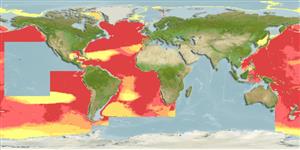Common names from other countries
>
Lophiiformes (Anglerfishes) >
Oneirodidae (Dreamers)
Etymology: Oneirodes: Greek, 'oneiros' = a dream or dreamlike or out of a dream (suggesting this fish is so strange and marvelous that can exist only in dreams) (Ref. 86949); eschrichtii: Named after D.F. Eschricht, Danish naturalist (Ref. 6885).
More on author: Lütken.
Environment: milieu / climate zone / depth range / distribution range
Ecologia
marinhas batipelágico; intervalo de profundidade 750 - 2500 m (Ref. 86949). Deep-water
Circumglobal: In tropical to temperate waters. Eastern Atlantic: off Madeira, Portugal, Ireland and Iceland.
Tamanho / Peso / Idade
Maturity: Lm ? range ? - ? cm
Max length : 28.8 cm SL macho/indeterminado; (Ref. 5951); 29.7 cm TL (female)
Descrição suscinta
Chaves de identificação | Morfologia | Morfometria
Raios dorsais (total) : 5 - 7; Raios anais : 4. Esca with anterior appendage bearing papillae and a few short filaments at distal tip; posterior appendage never branched. Characterized by having similar esca to that of O.bulbosus and O.anisacanthus; lacks numerous tapering distal filaments of the anterior appendage of O.bulbosus and lateral escal appendage of O.anisacanthus; subopercle without indentation on posterodorsal margin; length of ventral fork of opercle 20.7-31.9% SL; ratio of lengths of dorsal and ventral forks of opercle 0.44-0.69; absence of epibranchial teeth; presence of teeth on pharyngobrachial II; upper jaw teeth 24-50; lower jaw teeth 29-56;teeth on vomer 4-8; dorsal fin rays 5-7; anal fin rays 4; pectoral fin rays 15-19; head length 33.3-46.2% SL; head depth 34.7-55.4% SL; premaxilla length 22.4-38.9% SL; lower-jaw length 34.3-55.7% SL; illicium length 17.8-38.6& SL (Ref. 86949).
Mesopelagic species.
Ciclo de vida ou comportamento de acasalamento
Maturities | Reprodução | Spawnings | Egg(s) | Fecundities | Larvas
Bertelsen, E., 1990. Oneirodidae. p. 498-507. In J.C. Quero, J.C. Hureau, C. Karrer, A. Post, and L. Saldanha (eds.) Check-list of the fishes of the eastern tropical Atlantic (CLOFETA). JNICT, Lisbon; SEI, Paris; and UNESCO, Paris. Vol. 1. (Ref. 10524)
Status na Lista Vermelha da UICN (Ref. 130435)
CITES (Ref. 128078)
Not Evaluated
Ameaça para os humanos
Harmless
Uso pelos humanos
Ferramentas
Relatórios especiais
Baixar XML
Fontes da internet
Estimates based on models
Preferred temperature (Ref.
115969): 2.3 - 5.8, mean 3.6 (based on 1799 cells).
Índice de diversidade filogenética (Ref.
82804): PD
50 = 0.5000 [Uniqueness, from 0.5 = low to 2.0 = high].
Bayesian length-weight: a=0.01995 (0.00906 - 0.04395), b=3.01 (2.83 - 3.19), in cm Total Length, based on all LWR estimates for this body shape (Ref.
93245).
Nível Trófico (Ref.
69278): 4.4 ±0.7 se; based on size and trophs of closest relatives
Resiliência (Ref.
120179): médio(a), tempo mínimo de duplicação da população 1,4 - 4,4 anos (Preliminary K or Fecundity.).
Fishing Vulnerability (Ref.
59153): Low vulnerability (20 of 100).
